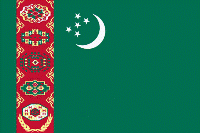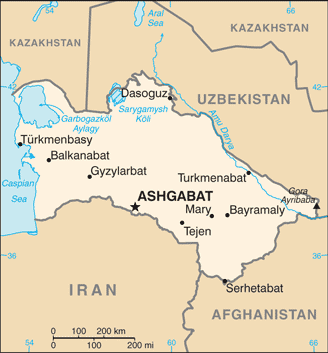Topics Covered
Welcome to Turkmenistan
Overview of Resources
Fossil Fuels
Investment
Sources
Welcome to Turkmenistan
Turkmenistan, with a total population of 5,054,828 as of July 2012, is located in Central Asia, bordering the Caspian Sea, between Iran and Kazakhstan. The country mostly has a subtropical desert climate and covers a total area of 488,100 km2. Turkmenistan is chiefly a desert country with sizeable oil and gas resources.
 |
The national flag of Turkmenistan.
Image Credit: CIA Factbook. |
Turkmenistan became a Soviet republic in 1924 and the country gained independence after the disintegration of the USSR in 1991. Although Turkmenistan lacked proper export routes for natural gas from 1998 to 2005, the country’s total exports between 2003 and 2008 increased by an average of about 15% annually. This increase was mainly because of the increase in international gas and oil prices. The country’s GDP as of 2011 was $43.91 billion.
The Russian pipeline network was the chief export route for Turkmenistan’s gas. However, the country succeeded in expanding its export routes for its gas by the construction of additional pipelines to China and Iran in 2010. With these new pipelines the country hopes to improve revenues and repair its economic situation.
Overview of Resources
Turkmenistan’s key natural resources include natural gas, petroleum, salt and sulfur. The country has some of the world largest natural gas reserves.
Some of the non-fuel minerals produced in the country are bischofite, sodium sulfate, bentonite, epsomite, bromine and iodine.
Fossil Fuels
In 2010, the Ministry of Oil, Gas, and Mineral Resources of Turkmenistan highlighted the need to increase the country’s production of gas to 230 billion m3 per year by 2030. From this total output 180 billion m3 of gas will be exported. Natural gas amounting to 44,270 billion m3 was produced in 2010.
As of January 2012, the country’s oil reserves were estimated to be 600 million barrels according to the Oil and Gas Journal. Turkmenistan’s onshore areas near the Caspian Sea is said to have most of the country’s oil fields.
Turkmenistan also has some of the world’s largest gas fields that are located in the Murgab basin in the east, the South Caspian basin in the west and the Amu Darya basin in the southeast.

The map of Turkmenistan. Image Credit: CIA Factbook
Investment
Turkmenistan has adequate gas reserves and thus hopes to expand its gas pipelines to China, India and Pakistan in the near future.
In 2011, China lent $4.1 billion to Turkmengaz, a state gas firm in Turkmenistan, in order to strengthen the partnership with the largest gas producer in Central Asia. This loan was planned to be utilized for the development of the second phase of the South Iolotan gas field that holds 21-22 trillion m3 of gas.
Another strategic partnership was established between Turkmenistan and Belarus in 2011 to carry out potash mining in Turkmenistan. Construction and agricultural machinery are exported by Belarus to Turkmenistan. Turkmenistan on the other hand exports petroleum products and petroleum to Belarus. The development of a business council for economic cooperation was another outcome of this partnership between Turkmenistan and Belarus.
Recent updates about the Belarus-Turkmenistan joint venture pointed out the intensive interaction between these two countries emphasizing on the development of the Garlyk mining and processing enterprise that will be utilized for the production of potash fertilizers in Turkmenistan. Commissioning of this project will take place in 2015. According to experts this project will lead to the production of potassium chloride amounting to 1.4 million t on an annual basis. Projects like this will indeed uplift Turkmenistan’s mining sector and thus contribute to improving the country’s economy.
The country’s economic growth rate will thus depend on further establishments of these joint ventures and also on foreign investments in order to increase its gas production that in turn will stabilize Turkmenistan’s financial sector.
Disclaimer: The Author of this article does not imply any investment recommendation and some content is speculative in nature. The Author is not affiliated in any way with any companies mentioned and all statistical information is publically available.
Sources
Disclaimer: The views expressed here are those of the author expressed in their private capacity and do not necessarily represent the views of AZoM.com Limited T/A AZoNetwork the owner and operator of this website. This disclaimer forms part of the Terms and conditions of use of this website.